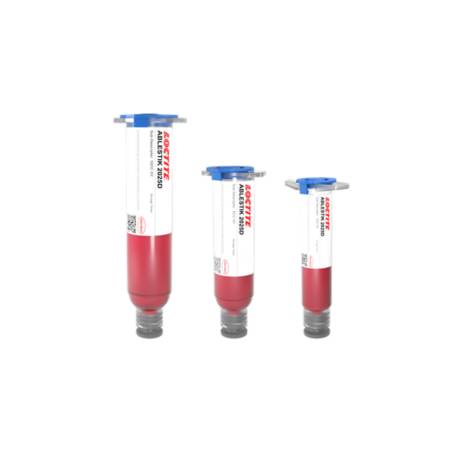LOCTITE ABLESTIK 2025D
- Excellent dispense capabilities
- For mother die in array packaging
- 260ºC reflow capability for Pb-free applications
Product Description
LOCTITE ABLESTIK 2025D is a Silica filled die attach adhesive with excellent dispense capabilities, designed for use in array packaging. Even though its properties are exceptional, Silica has the downside of potentially scratching the dies. That's why manufacturers tend to prefer the QMI range of products for stacking.
LOCTITE ABLESTIK 2025D has exceptional adhesion on Copper, excellent die sheer strength and MSL performance, something that makes it the product of choice for the first (mother) die. It performs excellently for this application and it compliments nicely the QMI products on die stacking applications. This product has low to medium modulus and can also be used for individual large die. This 0.4 W/mK product has also been qualified for automotive lid attach.
Cure Schedule
- 30 minute ramp to 175°C + 15 minutes @ 175°C
Technical Specifications
| General Properties | |
| Work life @25°C Work life @25°C Work life is the amount of time we have to work with a material until it is no longer able to be easily worked and applied on a substrate. It is based on the change in viscosity and it can rely on the application requirements. | 24 hours |
| Thermal Properties | |
| Thermal Conductivity Thermal Conductivity Thermal conductivity describes the ability of a material to conduct heat. It is required by power packages in order to dissipate heat and maintain stable electrical performance. Thermal conductivity units are [W/(m K)] in the SI system and [Btu/(hr ft °F)] in the Imperial system. | 0.4 W/m.K |
| Physical Properties | |
| Thixotropic index Thixotropic index Thixotropic Index is a ratio of a material s viscosity at two different speeds in Ambient temperature, generally different by a factor of ten. A thixotropic material s viscosity will decrease as agitation or pressure is increased. It indicates the capability of a material to hold its shape. Mayonnaise is a great example of this. It holds its shape very well, but when a shear stress is applied, the material easily spreads. It helps in choosing a material in accordance to the application, dispense method and viscosity of a material. | 4.4 |
| Viscosity Viscosity Viscosity is a measurement of a fluid’s resistance to flow. Viscosity is commonly measured in centiPoise (cP). One cP is defined as the viscosity of water and all other viscosities are derived from this base. MPa is another common unit with a 1:1 conversion to cP. A product like honey would have a much higher viscosity -around 10,000 cPs- compared to water. As a result, honey would flow much slower out of a tipped glass than water would. The viscosity of a material can be decreased with an increase in temperature in order to better suit an application | 11500 mPa.s |
Additional Information
What is a push tip and a screw tip
Tips are the plastic caps placed on the syringe's nozzle that need to be removed before dispensing.
Push tip is a type of tip that goes inside the nozzle while Screw tip wraps around the edge of the nozzle. There are no real functional differences other than this one and shouldn't affect the fit, form, function, or any aspect of the customer's process.
IDHs 1201771 and 1203572 have recently gone through this improvement process so this is a good place to share this information, just in case you were "affected".




